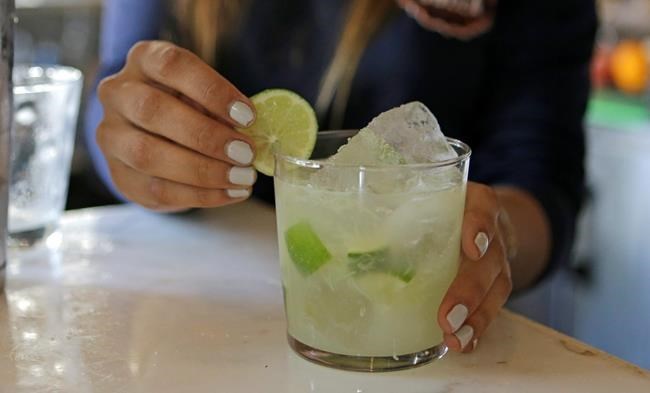
In this May 10, 2016 photo, bartender Rafaella Demelo adds a lime wedge for the final touch as a caipirinha is ready to be served at Bulla, a bar in Coral Gables, Fla. It’s tempting to call cachaca a Brazilian rum and think of the caipirinha as another muddled tropical cocktail. The upcoming Olympics in Rio de Janeiro may change that. Brazil’s national cocktail and unique distillation of sugarcane juice into a clear liquor are poised for the kind of worldwide exposure enjoyed by tequila after the 1968 Olympics in Mexico City and Australian wines after the 2000 Summer Games in Sydney. (AP Photo/Alan Diaz)
Republished July 21, 2016 - 12:58 PM
Original Publication Date July 21, 2016 - 9:35 AM
CORAL GABLES, Fla. - It's tempting to call cachaça a Brazilian rum and think of the caipirinha as another muddled tropical cocktail.
The upcoming Olympics in Rio de Janeiro may change that. Brazil's national cocktail and unique distillation of sugarcane juice into a clear liquor are poised for the kind of worldwide exposure enjoyed by tequila after the 1968 Olympics in Mexico City and Australian wines after the 2000 Summer Games in Sydney.
"We Americans love to consume the Olympics and 'travel' there without going there by drinking and eating and celebrating the culture of whatever the host country is, so I think a lot of people are going to be watching the Olympic Games with a caipirinha in their hands," Leblon Cachaça President and CEO Steve Luttmann said in a recent interview.
Cachaça (pronounced ka-SHAH-sah) and rum share origins in sugarcane but they are processed differently.
Cachaça, by definition, must be produced in Brazil with fresh sugarcane juice and contain alcohol by volume of 38 to 48 per cent. Rum can be made anywhere, and it's usually made from molasses and distilled at higher percentages of alcohol by volume.
The U.S. formally recognized cachaça as a distinct product of Brazil in 2013 after the two countries signed a trade agreement (in exchange, Brazil recognized bourbon and Tennessee whiskey as distinctive U.S. products).
The market for cachaça has steadily grown over the last decade, alongside the liquor industry's targeting of U.S. consumers' growing appreciation for premium rums. In April, 10 cachaça producers seeking U.S. distribution occupied a significant amount of trade expo space at the Miami Rum Renaissance Festival.
When Leblon launched in 2005, U.S. cachaça sales totalled just a few thousand cases sold mainly in Brazilian restaurants. Now owned by Bermuda-based industry giant Bacardi, Leblon boasts annual sales of 50,000 9-litre cases, Luttmann said.
"We found that when anybody consumed cachaça with the expectation of a rum, it tastes very different," said Luttmann, who led a "Legalize Cachaça" campaign to have the liquor recognized independently from rum.
While the caipirinha's sweet, tropical flavours may resemble a mojito, it's closer in spirit to a margarita, according to Luttmann.
"I would say that cachaça is more similar to tequila than rum," he said. "It's more similar to making tequila than it is to making a rum, in the context that they both use fresh juices from the raw material, from the fruit."
As the caipirinha has gained popularity in many bars, particularly those that hosted viewing parties for Brazil's World Cup two years ago, some bartenders now mix variations of the cocktail with vodka or sake and add strawberries, oranges or other fruits.
A true caipirinha — cachaça mixed with limes and ice — seems light but requires precision when mixing, said Rafaella Demelo, a Brazilian native and bartender at Bulla Gastrobar, a Spanish bar and restaurant in Coral Gables, Florida.
"It's a very simple drink but it's very hard to get it right. Not only do you have to know the amount of liquor to put in it but also the amount of limes to put in it, and the sugar as well," she said while mixing a caipirinha during a recent interview.
Aside from proper amounts of cachaça and white sugar, half a lime should be cut into cubes, "because a caipirinha is not only about the juice of the limes, but also about the bitters, the skin of the limes," Demelo said.
Shake the ingredients with ice and pour into a glass without straining.
"It has to be everything you used to make a caipirinha straight to the glass, otherwise you're not going to have the lime, you're not going to have the smell," Demelo said.
News from © The Associated Press, 2016